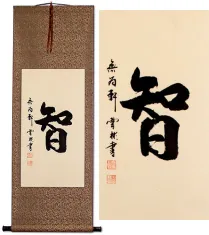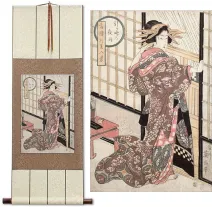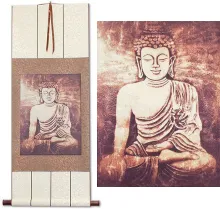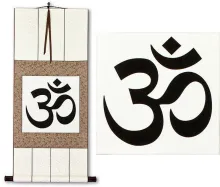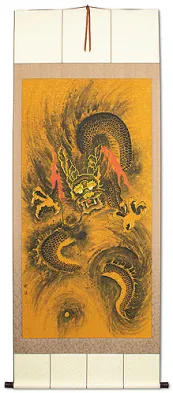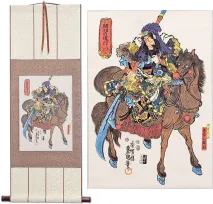Many custom options...
And formats...

Depth in Chinese / Japanese...
Sorry! There's currently no match for Depth in the calligraphy database...
If you want a special phrase, word, title, or proverb, feel free to contact me, and I'll translate your custom calligraphy idea for you.
These search terms might be related to Depth:
8. Right Concentration / Perfect Concentration
Always Striving for Inner Strength
Concentration
Conquering Yourself is a Sign of Strength
Control of Power
Courage and Strength
Determination to Achieve / Will-Power
Door of Great Wisdom
Each Time You Stumble and Fall, You Gain Experience and Wisdom
Experience is the Mother of Wisdom
Flexibility Overcomes Strength
Fortitude / Strength of Character
Fudo Myo-O / Wisdom King
Girl Power / Woman Power
God Give Me Strength
Good Health / Healthy / Vigor
Great Illumination of Wisdom
Great Lotus Wisdom - Samadhi Wisdom
Great Power
Great Wisdom
Herculean Strength
Inner Beauty / Inner Wisdom
Inner Strength
Inner Strength / Inner Well-Being and Health
Inner Strength / Self-Improvement
Inner Strength is Better Than Outward Appearance
Inner Wisdom
Intensity
Intuitive Wisdom / Inner Light
Juggernaut / Absolute Power
Learn From Wisdom
Love Faith Strength
Mystic Lotus Wisdom of Amitabha
Perseverance / Will-Power
Physical Strength
Power / Strength
Power of Oneself / Self-Sufficient
Power of Understanding and Wisdom
Psychic Power
Seeker of Wisdom
Seeking Wisdom
Self-Discipline / Will-Power
Spiritual Strength / Strength of Spirit
Stamina / Vigor
Strength / Ability
Strength / Vigor / Energy
Strength and Courage
Strength and Honor
Strength and Love
Strength and Love in Unity
Strength Love Honor
Strength: Strong and Solid
The Spirit of the Dragon Horse and Power of a Tiger
The Wisdom of the Many
When Three People Gather, Wisdom is Multiplied
Will-Power / Self-Control
Wisdom
Wisdom / Brilliance
Wisdom / Intelligence
Wisdom and Insight of the Buddha
Wisdom Comes From Experience
Wisdom From Hard Knocks
Wisdom Lotus
With All the Strength of Your Heart
Below are some entries from our dictionary that may match your depth search...
| Characters If shown, 2nd row is Simp. Chinese |
Pronunciation Romanization |
Simple Dictionary Definition |
地獄 地狱 see styles |
dì yù di4 yu4 ti yü jigoku じごく |
More info & calligraphy: Hell(1) {Buddh} hell realm; Naraka; (2) {Christn} Hell; (3) hell; misery; nightmare; inferno; (4) place where a volcano or hot springs constantly spew smoke or steam; (place-name) Jigoku naraka, 捺落迦 (or 那落迦) ; niraya 泥犂; explained by 不樂 joyless; 可厭 disgusting, hateful; 苦具, 苦器 means of suffering; if 地獄 earth-prison; 冥府 the shades, or departments of darkness. Earth-prison is generally intp. as hell or the hells; it may also be termed purgatory; one of the six gati or ways of transmigration. The hells are divided into three classes: I. Central, or radical, 根本地獄 consisting of (1) The eight hot hells. These were the original hells of primitive Buddhism, and are supposed to be located umder the southern continent Jambudvīpa 瞻部州, 500 yojanas below the surface. (a) 等活 or 更活 Saṃjīva, rebirth, where after many kinds of suffering a cold wind blows over the soul and returns it to this life as it was before, hence the name 等活. (b) 黑繩 Kaslasūtra, where the sufferer is bound with black chains and chopped or sawn asunder. (c) 線合; 衆合; 堆壓 Saṃghāta, where are multitudes of implements of torture, or the falling of mountains upon the sufferer. (d) 號呌; 呼呼; 叫喚 Raurava, hell of wailing. (e) 大呌; 大號呌; 大呼 Mahāraurava, hell of great wailing. (f) 炎熱; 燒炙 Tapana, hell of fames and burning. (g) 大熱; 大燒炙; 大炎熱 Pratāpana, hell of molten lead. (h) 無間; 河鼻旨; 阿惟越致; 阿毗至; 阿鼻; 阿毗 Avīci, unintermitted suffering, where sinners die and are reborn to suffer without interval. (2) The eight cold hells 八寒地獄. (a) 頞浮陀地獄 Arbuda, where the cold causes blisters. (b) 尼刺部陀 Nirarbuda, colder still causing the blisters to burst. (c) 頞哳吒; 阿吒吒 Atata, where this is the only possible sound from frozen lips. (d) 臛臛婆; 阿波波 Hahava or Apapa, where it is so cold that only this sound can be uttered. (e) 虎虎婆 Hāhādhara or Huhuva, where only this sound can be uttered. (f) 嗢鉢羅; 鬱鉢羅 (or 優鉢羅) Utpala, or 尼羅鳥 (or 漚) 鉢羅 Nīlotpala, where the skin is frozen like blue lotus buds. (g) 鉢特摩 Padma, where the skin is frozen and bursts open like red lotus buds. (h) 摩訶鉢特摩 Mahāpadma, ditto like great red lotus buds. Somewhat different names are also given. Cf. 倶舍論 8; 智度論 16; 涅槃經 11. II. The secondary hells are called 近邊地獄 adjacent hells or 十六遊增 each of its four sides, opening from each such door are four adjacent hells, in all sixteen; thus with the original eight there are 136. A list of eighteen hells is given in the 十八泥梨經. III. A third class is called the 孤地獄 (獨地獄) Lokāntarika, or isolated hells in mountains, deserts, below the earth and above it. Eitel says in regard to the eight hot hells that they range 'one beneath the other in tiers which begin at a depth of 11,900 yojanas and reach to a depth of 40,000 yojanas'. The cold hells are under 'the two Tchahavālas and range shaft-like one below the other, but so that this shaft is gradually widening to the fourth hell and then narrowing itself again so that the first and last hell have the shortest, those in the centre the longest diameter'. 'Every universe has the same number of hells, ' but 'the northern continent has no hell whatever, the two continents east and west of Meru have only small Lokāntarika hells... whilst all the other hells are required for the inhabitants of the southern continent '. It may be noted that the purpose of these hells is definitely punitive, as well as purgatorial. Yama is the judge and ruler, assisted by eighteen officers and a host of demons, who order or administer the various degrees of torture. 'His sister performs the same duties with regard to female criminals, ' and it may be mentioned that the Chinese have added the 血盆池 Lake of the bloody bath, or 'placenta tank' for women who die in childbirth. Release from the hells is in the power of the monks by tantric means. |
仞 see styles |
rèn ren4 jen jin じん |
unit of length used in ancient times, equal to 7 or 8 Chinese feet 尺[chi3] ren (ancient Chinese measure of height, depth, etc.; between 1-3 meters) |
仭 see styles |
mitsuru みつる |
ren (ancient Chinese measure of height, depth, etc.; between 1-3 meters); (given name) Mitsuru |
漼 see styles |
cuǐ cui3 ts`ui tsui |
having the appearance of depth |
藴 see styles |
yùn yun4 yün |
variant of 蘊|蕴, to accumulate; to hold in store; to contain; to gather together; to collect; depth; inner strength; profundity |
蘊 蕴 see styles |
yùn yun4 yün osamu おさむ |
to accumulate; to hold in store; to contain; to gather together; to collect; depth; inner strength; profundity (given name) Osamu skandha, v. 塞; older tr. 陰, intp. as that which covers or conceals, implying that physical and mental forms obstruct realization of the truth; while the tr. 蘊, implying an accumulation or heap, is a nearer connotation to skandha, which, originally meaning the shoulder, becomes stem, branch, combination, the objects of sense, the elements of being or mundane consciousness. The term is intp. as the five physical and mental constituents, which combine to form the intelligent 性 or nature; rūpa, the first of the five, is considered as physical, the remaining four as mental; v. 五蘊. The skandhas refer only to the phenomenal, not to the 無爲 non-phenomenal. |
わね see styles |
wane ワネ |
(expression) (feminine speech) (sentence end) (See わ・1,ね・1) expresses depth of feeling or emphasis; (personal name) Vane |
万仞 see styles |
banjin ばんじん |
10000 fathoms; great depth; great height |
万尋 see styles |
mahiro まひろ |
10000 fathoms; great depth; great height; (female given name) Mahiro |
中層 中层 see styles |
zhōng céng zhong1 ceng2 chung ts`eng chung tseng chuusou / chuso ちゅうそう |
middle-ranking (1) middle part; medium depth (water); medium layer; middle lamella; (can be adjective with の) (2) medium-size; mid-level; medium-rise (building) |
千仞 see styles |
chihiro ちひろ |
(1) great depth; bottomless; (2) great height; (given name) Chihiro |
千尋 see styles |
chihiro ちひろ |
(1) great depth; bottomless; (2) great height; (surname, female given name) Chihiro |
含蓄 see styles |
hán xù han2 xu4 han hsü ganchiku がんちく |
to contain; to hold; (of a person or style etc) reserved; restrained; (of words, writings) full of hidden meaning; implicit; veiled (criticism) (noun/participle) implication; significance; connotation; depth of meaning; complications of a problem |
奥行 see styles |
okuyuki おくゆき |
depth; length; (place-name) Okuyuki |
学ぶ see styles |
manabu まなぶ |
(Godan verb with "bu" ending) to study (in depth); to learn; to take lessons in |
學ぶ see styles |
manabu まなぶ |
(out-dated kanji) (Godan verb with "bu" ending) to study (in depth); to learn; to take lessons in |
安居 see styles |
ān jū an1 ju1 an chü yasuoki やすおき |
to settle down; to live peacefully (n,vs,vi) {Buddh} varsika (meditation retreat; usu. for 90 days starting on the 15th day of the 4th month of the lunisolar calendar); (given name) Yasuoki Tranquil dwelling. varṣā, varṣās, or varṣāvasāna. A retreat during the three months of the Indian rainy season, and also, say some, in the depth of winter. During the rains it was 'difficult to move without injuring insect life'. But the object was for study and meditation. In Tokhara the retreat is said to have been in winter, from the middle of the 12th to the middle of the 3rd moon; in India from the middle of the 5th to the 8th, or the 6th to the 9th moons; usually from Śrāvaṇa, Chinese 5th moon, to Aśvayuja, Chinese 8th moon; but the 16th of the 4th to the 15th of the 7th moon has been the common period in China and Japan. The two annual periods are sometimes called 坐 夏 and 坐 臘 sitting or resting for the summer and for the end of the year. The period is divided into three sections, former, middle, and latter, each of a month. |
幽深 see styles |
yōu shēn you1 shen1 yu shen yūshin |
serene and hidden in depth or distance mysterious and deep |
心碎 see styles |
xīn suì xin1 sui4 hsin sui |
heartbroken; extreme depth of sorrow |
心骨 see styles |
shinkotsu しんこつ |
(1) body and soul; mind and body; (2) bottom of one's heart; depth of one's heart |
忍水 see styles |
rěn shuǐ ren3 shui3 jen shui ninsui |
Patience in its depth and expanse compared to water. |
探水 see styles |
tàn shuǐ tan4 shui3 t`an shui tan shui tansui |
To sound the depth of water, the lower part of a staff, i.e. for sounding depth. |
景深 see styles |
jǐng shēn jing3 shen1 ching shen |
depth of field |
欲海 see styles |
yù hǎi yu4 hai3 yü hai yokukai |
ocean of lust (Buddhist term); worldly desires The ocean of desire, so called because of its extent and depth. |
水性 see styles |
shuǐ xìng shui3 xing4 shui hsing mizushou / mizusho みずしょう |
swimming ability; characteristics of a body of water (depth, currents etc); aqueous; water-based (paint etc) fluidity; wanton nature of water |
水深 see styles |
shuǐ shēn shui3 shen1 shui shen mizubuka みずぶか |
depth (of waterway); sounding depth of water; (place-name) Mizubuka |
海深 see styles |
umi うみ |
depth of the sea; (female given name) Umi |
深さ see styles |
fukasa ふかさ |
depth; profundity |
深み see styles |
fukami ふかみ |
depth; deep place |
深味 see styles |
fukami ふかみ |
depth; deep place; (place-name, surname) Fukami |
Click here for more depth results from our dictionary
This in-stock artwork might be what you are looking for, and ships right away...
South China River Boat
Landscape Painting
Discounted Blemished
Gallery Price: $27.00
Your Price: $15.00
Gallery Price: $200.00
Your Price: $98.88
Gallery Price: $150.00
Your Price: $78.88
Gallery Price: $108.00
Your Price: $59.88
Gallery Price: $108.00
Your Price: $59.88
Gallery Price: $108.00
Your Price: $59.88
Gallery Price: $240.00
Your Price: $148.88
Gallery Price: $108.00
Your Price: $59.88
Gallery Price: $108.00
Your Price: $59.88
Asian Beauty
Beautiful Chinese Woman Painting
Discounted Blemished
Gallery Price: $89.00
Your Price: $49.00
Successful Chinese Character and Japanese Kanji calligraphy searches within the last few hours...



